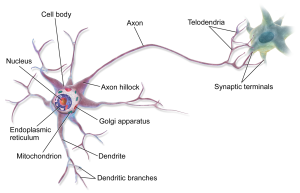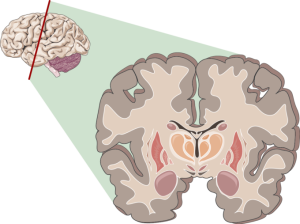The Cerebral Cortex
Rachel Jessop and Jim Hutchins
Objective
1. Identify the parts of a neuron and trace how an action potential is sent.
2. Explain why myelination is important in cell communication.
3. Understand the difference between white and gray matter.
The cerebrum is the largest portion of the brain and is divided into two (right and left) hemispheres. The cerebrum is made of white (inside) and gray (outer) matter. The gray matter is also known as the cerebral cortex. To understand the difference between gray and white matter, we must first review the components of a neuron.
Nucleus: Like any other eukaryotic cell, the neuron has a nucleus to contain its genetic material. It is responsible for coordinating cellular activities.
Cell body: The cell body contains the nucleus and cell organelles. It connects the incomi ng dendritic signals to the outgoing axonal ones.
ng dendritic signals to the outgoing axonal ones.
Dendrite: These branch-like projections collect incoming signals from other neurons.
Axon hillock: At the end of the cell body and the beginning of the axon, there is a tapering point that marks the beginning of the axon. Its job is to potentiate electric impulses, or action potentials, down the axon.
Axon: The long, thin projection coming out from the cell body is the axon. This structure is how neural information is carried from one point to another.
Synaptic terminal: At the end of the axon is the synaptic terminal, which allows neurons to communicate to one another. This area is where neurotransmitters are released from axon to dendrite.
Not present on this particular neuron is myelin. It is a fatty substance that wraps around the axon tract in segments. Though not present on all neurons, myelin plays an important role in cell signaling. It acts as an insulator, similar to electrical wires wrapped in plastic. When an impulse travels down a myelinated axon, the potentials “jump” from one portion of exposed axon to another, a mechanism called saltatory conduction. This speeds up axonal communication tremendously.

Gray matter consists of neuron cell bodies, dendrites, and unmyelinated axons. White matter mainly consists of myelinated axons.

